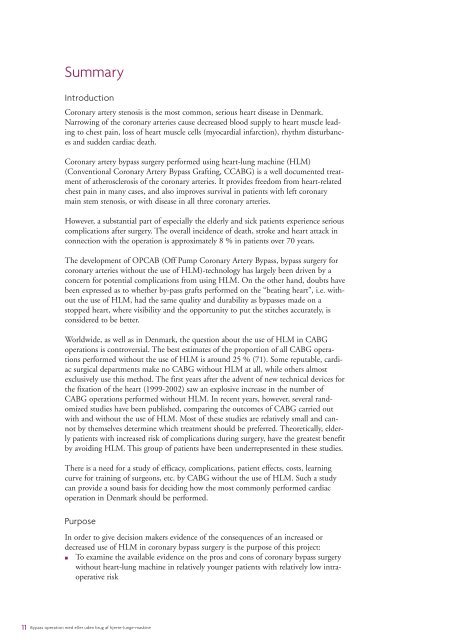MTV-rapport om bypass operationer - Sundhedsstyrelsen
MTV-rapport om bypass operationer - Sundhedsstyrelsen
MTV-rapport om bypass operationer - Sundhedsstyrelsen
Create successful ePaper yourself
Turn your PDF publications into a flip-book with our unique Google optimized e-Paper software.
Summary<br />
Introduction<br />
Coronary artery stenosis is the most c<strong>om</strong>mon, serious heart disease in Denmark.<br />
Narrowing of the coronary arteries cause decreased blood supply to heart muscle leading<br />
to chest pain, loss of heart muscle cells (myocardial infarction), rhythm disturbances<br />
and sudden cardiac death.<br />
Coronary artery <strong>bypass</strong> surgery performed using heart-lung machine (HLM)<br />
(Conventional Coronary Artery Bypass Grafting, CCABG) is a well documented treatment<br />
of atherosclerosis of the coronary arteries. It provides freed<strong>om</strong> fr<strong>om</strong> heart-related<br />
chest pain in many cases, and also improves survival in patients with left coronary<br />
main stem stenosis, or with disease in all three coronary arteries.<br />
However, a substantial part of especially the elderly and sick patients experience serious<br />
c<strong>om</strong>plications after surgery. The overall incidence of death, stroke and heart attack in<br />
connection with the operation is approximately 8 % in patients over 70 years.<br />
The development of OPCAB (Off Pump Coronary Artery Bypass, <strong>bypass</strong> surgery for<br />
coronary arteries without the use of HLM)-technology has largely been driven by a<br />
concern for potential c<strong>om</strong>plications fr<strong>om</strong> using HLM. On the other hand, doubts have<br />
been expressed as to whether by-pass grafts performed on the “beating heart”, i.e. without<br />
the use of HLM, had the same quality and durability as <strong>bypass</strong>es made on a<br />
stopped heart, where visibility and the opportunity to put the stitches accurately, is<br />
considered to be better.<br />
Worldwide, as well as in Denmark, the question about the use of HLM in CABG<br />
operations is controversial. The best estimates of the proportion of all CABG operations<br />
performed without the use of HLM is around 25 % (71). S<strong>om</strong>e reputable, cardiac<br />
surgical departments make no CABG without HLM at all, while others almost<br />
exclusively use this method. The first years after the advent of new technical devices for<br />
the fixation of the heart (1999-2002) saw an explosive increase in the number of<br />
CABG operations performed without HLM. In recent years, however, several rand<strong>om</strong>ized<br />
studies have been published, c<strong>om</strong>paring the outc<strong>om</strong>es of CABG carried out<br />
with and without the use of HLM. Most of these studies are relatively small and cannot<br />
by themselves determine which treatment should be preferred. Theoretically, elderly<br />
patients with increased risk of c<strong>om</strong>plications during surgery, have the greatest benefit<br />
by avoiding HLM. This group of patients have been underrepresented in these studies.<br />
There is a need for a study of efficacy, c<strong>om</strong>plications, patient effects, costs, learning<br />
curve for training of surgeons, etc. by CABG without the use of HLM. Such a study<br />
can provide a sound basis for deciding how the most c<strong>om</strong>monly performed cardiac<br />
operation in Denmark should be performed.<br />
Purpose<br />
In order to give decision makers evidence of the consequences of an increased or<br />
decreased use of HLM in coronary <strong>bypass</strong> surgery is the purpose of this project:<br />
• To examine the available evidence on the pros and cons of coronary <strong>bypass</strong> surgery<br />
without heart-lung machine in relatively younger patients with relatively low intraoperative<br />
risk<br />
11 Bypass operation med eller uden brug af hjerte-lunge-maskine

















